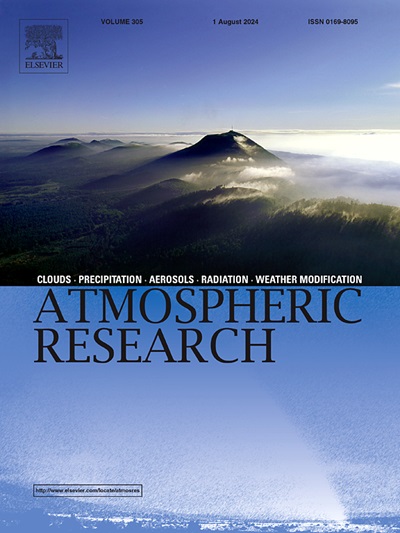揭示澳大利亚浅锋面在南风巴斯特事件(1994-2020 年)期间的动态变化
IF 4.5
2区 地球科学
Q1 METEOROLOGY & ATMOSPHERIC SCIENCES
引用次数: 0
摘要
锋面识别系统(FIS)最初设计用于跟踪比斯开湾的加勒纳斯(Galernas),后经调整,利用ERA5 每小时再分析数据得出的风向变化监测澳大利亚各地的冷锋。这种高分辨率系统可以在温暖季节跟踪浅层无云锋面,这些锋面可能引发丛林大火、沙尘暴、极端高温和沿海极端天气,如东海岸的 "南风吹袭"(Southerly Busters,SB)。SB 事件的特点是突然刮起狂暴的南风,对划船和航空造成危害。我们对 1994 年至 2020 年的 35 次 SB 事件进行的分析表明,SB 起源于巴斯海峡的锋面生成(40%)或穿越海峡的前锋槽(60%)。在此之前的合流条件包括南大洋冷锋驱动冷海上风进入澳大利亚热低气压,形成浅层辐合锋(深度达 1000 米),面对温暖的大陆风。进入热低气压的陆上加速使这些新锋面(南部海岸的 2 型锋面)变得尖锐,并削弱了尾随的主海洋锋面,由于高压波传播、冷平流和海面下沉,主海洋锋面可能会消失。这些锋面可能深入内陆(澳大利亚中部锋面),并在与大分水岭相互作用后在东南海岸引发 SB。所有 35 个 SB 事件都显示了活跃的浅层锋面生成/锋面溶解作用,影响了南部海岸和内陆地区。大陆上空的热低气压和海洋低气压之间的高层反向气压梯度在内陆浅层冷平流上方维持了一个风切变区域。地表锋以南的强烈暖西北风,在 700 至 550 hPa 之间的风速为 35-50 m s-1,有助于在 SB 发生之前形成中锋。这股喷流还在大分水岭上空维持着强大的跨山风,导致东海岸所有 SB 事件发生前的沿海地带出现利槽。了解这些动态有助于更有效地预测和管理这些事件。本文章由计算机程序翻译,如有差异,请以英文原文为准。
Unveiling the dynamics of shallow fronts in Australia during Southerly Buster episodes (1994–2020)
A Frontal Identification System (FIS), initially designed to track Galernas in the Bay of Biscay, has been adapted to monitor cold fronts across Australia using wind shifts derived from ERA5 hourly reanalysis data. This high-resolution system tracks shallow, cloud-free fronts during the warm season, which can trigger bushfires, dust storms, extreme heat, and coastal weather extremes like Southerly Busters (SB) on the east coast. SB episodes, marked by sudden, squally south winds, pose hazards for boating and aviation. Our analysis of 35 SB events from 1994 to 2020 indicates that SBs originate from frontogenesis in Bass Strait (40 %) or from prefrontal troughs crossing the strait (60 %). Preceding synoptic conditions involve a Southern Ocean cold front driving cool maritime winds into the Australian thermal low, creating shallow convergence fronts (∼1000 m deep) facing warm continental winds. Onshore acceleration into the thermal low sharpens these new fronts (Type 2 fronts of the southern coast) and weakens the trailing primary ocean front, which may disappear due to high-pressure wave propagation, cold advection, and subsidence over the sea. These fronts can penetrate deep inland (Central Australian fronts) and initiate SBs on the southeast coast after interacting with the Great Dividing Range. All 35 SB events show active shallow front frontogenesis/frontolysis affecting the southern coast and inland regions. Upper-level reversed pressure gradients between the thermal low over the continent and the ocean depression maintain a wind shear region over the shallow inland cold advection. Intense warm north-westerlies south of the surface front, with wind speeds of 35–50 m s−1 between 700 and 550 hPa, contribute to mesofront formation preceding SB episodes. This jet also sustains strong cross-mountain winds over the Great Dividing Range, causing the lee trough at the coastal strip that precedes all SB episodes on the eastern coast. Understanding these dynamics can help predict and manage these events more effectively.
求助全文
通过发布文献求助,成功后即可免费获取论文全文。
去求助
来源期刊

Atmospheric Research
地学-气象与大气科学
CiteScore
9.40
自引率
10.90%
发文量
460
审稿时长
47 days
期刊介绍:
The journal publishes scientific papers (research papers, review articles, letters and notes) dealing with the part of the atmosphere where meteorological events occur. Attention is given to all processes extending from the earth surface to the tropopause, but special emphasis continues to be devoted to the physics of clouds, mesoscale meteorology and air pollution, i.e. atmospheric aerosols; microphysical processes; cloud dynamics and thermodynamics; numerical simulation, climatology, climate change and weather modification.
 求助内容:
求助内容: 应助结果提醒方式:
应助结果提醒方式:


